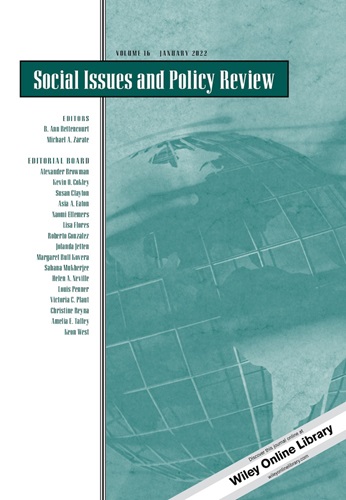重新思考减少暴力训练项目中的旁观者效应
IF 5.6
1区 心理学
Q1 PSYCHOLOGY, SOCIAL
引用次数: 13
摘要
许多暴力预防项目都注重旁观者和第三方在暴力预防培训中的作用。这项工作的核心是关于“旁观者效应”的经典社会心理学研究。然而,最近对旁观者行为的研究表明,在暴力或危险的突发事件中,旁观者效应并不成立。文献荟萃分析表明,在紧急情况下,他人的存在既可以促进也可以抑制干预。对闭路电视摄像机拍摄的现实生活中旁观者行为的研究表明,一些旁观者干预是常态,旁观者成为受害者的可能性很低。减少暴力项目效果有限的一个原因可能是他们对待旁观者的方式。我们认为减少暴力项目应该:认识到一些干预是可能的(尽管它可能并不总是成功的);将团体视为成功干预的途径,而不是对任何个人成为干预者的可能性的威胁;告知旁观者受害的真正风险;利用旁观者、受害者和加害者之间社会关系的力量,提高干预的成功率;寻求在现场提供旁观者干预培训,而不是离开侵略或暴力的背景。本文章由计算机程序翻译,如有差异,请以英文原文为准。
Rethinking the Bystander Effect in Violence Reduction Training Programs
Many violence prevention programs include a focus on the role of bystanders and third parties in violence prevention training. Central to this work has been the classic social psychological research on the “bystander effect”. However, recent research on bystander behavior shows that the bystander effect does not hold in violent or dangerous emergencies. Meta‐analyses of the literature show that the presence of others can facilitate as well as inhibit intervention in emergencies. Studies of real‐life bystander behavior captured on CCTV cameras shows that some bystander intervention is the norm and that the likelihood of bystanders being victimized is low. One reason for the limited effectiveness of violence reduction programs may be their approach to bystanders. We argue that violence reduction programs should: recognize that some intervention is likely (although it may not always be successful); see the group as a route to successful intervention rather than a threat to the likelihood of any single individual becoming an intervener; inform bystanders of the real risks of victimization; utilize the power of social relations between bystanders, victims, and perpetrators to enhance successful intervention; seek to deliver bystander intervention training in situ, rather than away from the context of the aggression or violence.
求助全文
通过发布文献求助,成功后即可免费获取论文全文。
去求助
来源期刊

Social Issues and Policy Review
Multiple-
CiteScore
22.20
自引率
1.10%
发文量
9
期刊介绍:
The mission of Social Issues and Policy Review (SIPR) is to provide state of the art and timely theoretical and empirical reviews of topics and programs of research that are directly relevant to understanding and addressing social issues and public policy.Papers will be accessible and relevant to a broad audience and will normally be based on a program of research. Works in SIPR will represent perspectives directly relevant to the psychological study of social issues and public policy. Contributions are expected to be review papers that present a strong scholarly foundation and consider how research and theory can inform social issues and policy or articulate the implication of social issues and public policy for theory and research.
 求助内容:
求助内容: 应助结果提醒方式:
应助结果提醒方式:


